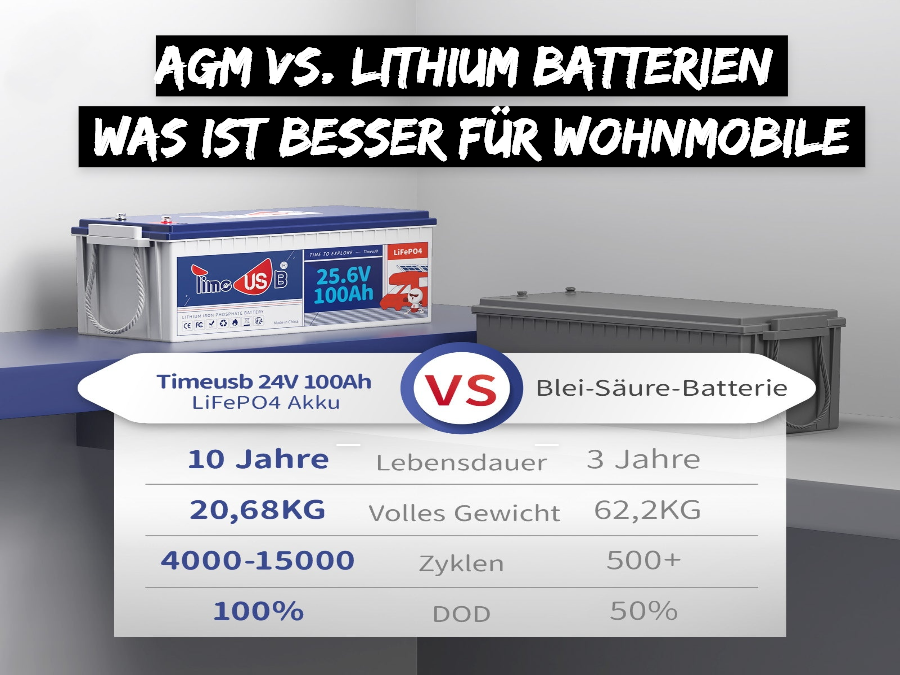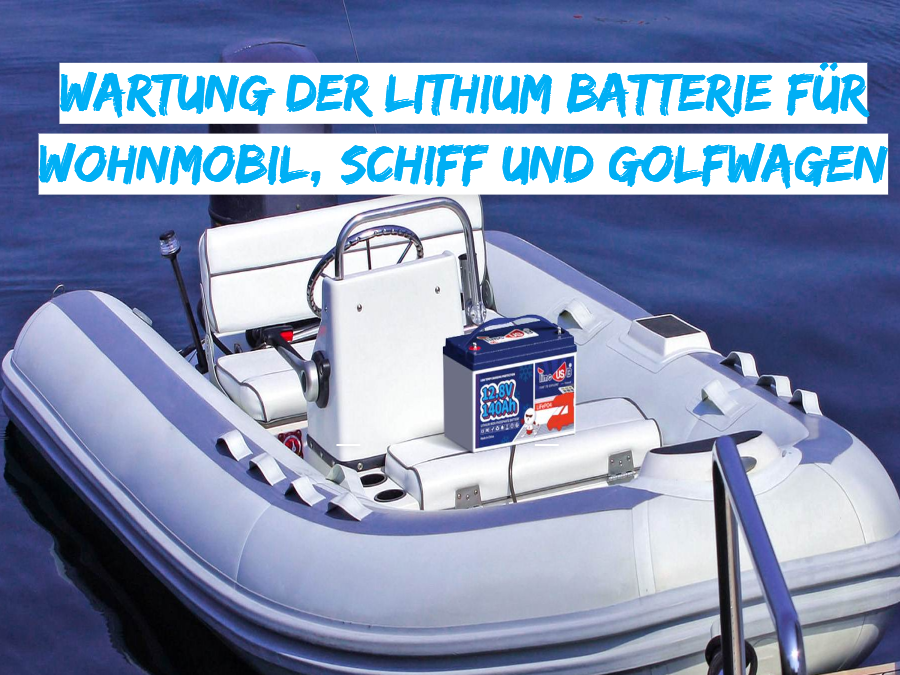[Guide] Comprehensive guide to LiFePO4 battery lifespan
![[Anleitung ] Umfassender Leitfaden zur Lebensdauer von LiFePO4 Batterie](http://timeusbpower.de/cdn/shop/articles/4_Stuck_Timeusb12V_200Ah_Pro_LiFePO4_Batterien.jpg?v=1727504398&width=1600)
lithium-ion battery(Li Ion) is becoming increasingly popular as the world moves to clean and sustainable energy. These batteries are known for their high energy density and long lifespan and have revolutionized the industry. However, many users often ask themselves: "How long do lithium ion batteries last? In this article, we will explore this question and examine how LiFePO4 battery, an advanced type of lithium ion battery, in terms of their longevity.
table of contents
- Part 1. What is a lithium ion battery?
- Part 2. How long do lithium ion batteries last?
- Part 3. Factors affecting the lifespan of lithium ion batteries
- 3.1 During storage
- 3.2 When cycling
- Part 4. Ways to extend the life of lithium ion batteries
- Part 5. Frequently asked questions about lithium ion batteries
- Part 6. Is it worth investing in lithium ion batteries?
Part 1. What is a lithium ion battery?
Lithium ion battery, including lithium iron phosphate battery (LiFePO4), are rechargeable and use lithium ions as the main component of the electrolyte. LiFePO4 batteries offer several advantages over other battery types, such as longer life, higher efficiency and energy density, lower maintenance, greater safety and environmental friendliness. These properties make them ideal for off-grid energy systems, high power applications and mobile solutions.
Lithium ion batteries are often used as starter batteries in vehicles due to their high energy density and low weight. They are well suited for this application because they can deliver a high current for a short time to start the engine. However, lithium ion batteries used as starter batteries usually have a low capacity and should not be discharged too much to avoid damage.
In contrast, LiFePO4 batteries are ideal as deep cycle batteries. LiFePO4 batteries have a longer cycle life than lithium ion batteries and offer high performance over a longer period of time.

Part 2. How long do lithium ion batteries last?
Standard lithium ion batteries have an average lifespan of 2-3 years, depending on use. With proper care and following the manufacturer's instructions, the lifespan can be extended to five years. Lithium ion batteries are temperature sensitive, and high temperatures can significantly shorten their lifespan. Therefore, it is important to store lithium ion batteries in a cool, dry place to avoid high temperatures and extend their lifespan.
LiFePO4 batteries are a more advanced and sustainable type of lithium ion battery that is becoming increasingly popular in the industry. These batteries have a longer lifespan than standard lithium ion batteries, up to 10 years or more. In addition, LiFePO4 batteries are very stable and safe and represent a more reliable and sustainable solution for off-grid power supplies and mobile applications.
A key advantage of LiFePO4 batteries is their ability to handle more charge and discharge cycles. While standard lithium ion batteries can withstand up to 500-1,000 cycles, LiFePO4 batteries can withstand up to 2.000 cycles, making them a more durable and cost-effective solution in the long run. Timeusb LiFePO4 batteries can last between 4,000 and 15,000 cycles and have a lifespan of over 10 years, making them an ideal replacement for lead acid batteries. The lifespan is between 4,000 and 15,000 cycles, making them an ideal replacement for lead acid batteries. In addition, LiFePO4 batteries are safer than traditional lithium ion batteries because their chemistry means they are less likely to overheat or explode.
Timeusb offers high quality LiFePO4 batteries designed for long life, efficiency and sustainability. We offer a wide range of battery sizes and capacities for a variety of off-grid and mobile applications. We pride ourselves on the quality and durability of our batteries and test them thoroughly to ensure customer satisfaction.
Part 3. Factors affecting the lifespan of lithium ion batteries
Based on the investigation of the factors that affect the service life of lithium ion batteries, the following factors can be mentioned that can affect the service life of lithium ion batteries.
3.1 During storage
1) Temperature
The main cause of capacity loss in batteries during storage is temperature, with higher temperatures accelerating the thermal decomposition of electrodes and electrolytes.
As the electrolyte decomposes, the thickness of the film at the solid electrolyte interface (SEI) on the anode increases, consuming lithium ions, increasing internal resistance and reducing battery capacity. This decomposition also produces gases that increase internal pressure and pose a safety risk. As shown in Table 3.1, lithium ion batteries stored at the same state of charge (40%) and different temperatures lose different amounts of capacity over the course of a year.
Battery degradation increases with increasing temperatures, with extreme temperatures significantly accelerating capacity loss. For example, a temperature increase from 0°C to 25°C results in a capacity loss of only 2%, while a 20°C increase from 40°C to 60°C results in a capacity loss of 10%.
Table 3.1
Temperatures above 30°C are very stressful for lithium-ion batteries and can significantly shorten the battery's lifespan. To extend the battery's lifespan, it is recommended to store lithium-ion batteries at temperatures between 5°C and 20°C.
2) State of charge (SOC)
As shown in Figure 3.2, the open circuit voltage (OCV) of a lithium-ion battery increases with increasing state of charge (SOC). The higher the SOC of the battery, the higher the OCV during storage. However, an increase in OCV leads to growth of the solid electrolyte interface (SEI) and oxidation of the electrolyte, resulting in capacity loss and increased internal resistance (IR).
 Figure 3.2
Figure 3.2
Figure 3.3 shows the different degradation rates of lithium ion batteries after ten years of storage at different SOC values. As the SOC value increases, the remaining capacity of the Li-ion battery decreases faster.

Figure 3.3
To minimize battery degradation and extend service life, it is recommended to store lithium ion batteries at a medium SOC value.It is recommended to charge or discharge lithium ion batteries to approximately 50% SOC before storage.
3.2 When cycling
1) Temperature:
While operating a battery at higher temperatures can temporarily improve performance, prolonged driving at high temperatures can shorten the battery's lifespan. For example, a battery operating at 30°C will have a 20% shorter lifespan, and at 45°C the lifespan is halved compared to a battery operating at 20°C.
The manufacturer recommends a nominal operating temperature of 27°C to optimize battery performance. On the other hand, very low temperatures increase the internal resistance and reduce the discharge capacity. A battery that has 100% capacity at 27°C will only have 50% capacity at -18°C.
The discharge capacity of lithium polymer battery varies with temperature and is lower at low temperatures (0°C, -10°C, -20°C) than at high temperatures (25°C, 40°C, 60°C). Charging lithium ion batteries at low temperatures (below 15°C) can accelerate the deterioration of battery performance because the embedding of lithium ions slows down and causes lithium plating, which increases the internal resistance and further reduces the discharge capacity.

Figure 3.4
To maximize the lifespan and performance of lithium ion batteries, it is recommended to use them at moderate temperatures. A temperature of 20 °C or slightly below is optimal for maximum lifespan. However, to maximize battery life, the manufacturer recommends a slightly higher temperature of 27 °C.
2) Depth of discharge
Depth of discharge (DOD) has a significant impact on the lifespan of lithium ion batteries. A deeper discharge creates pressure inside the battery and damages the negative electrode position, which accelerates capacity loss and increases the risk of battery damage. As shown in Figure 3.5, deeper discharge cycles result in a shorter battery life.

Figure 3.5
A depth of discharge of more than 50% is called deep discharge. When the voltage of a lithium ion battery drops from 4.2 V to 3.0 V, about 95% of its energy is used up, resulting in the shortest battery life in continuous use. To minimize the loss of capacity, it is recommended to use the batteries in such a way that full discharge is avoided. Partial discharging and recharging of lithium ion batteries can help extend their lifespan.
Manufacturers typically rate batteries using the 80% depth of discharge (DOD) formula, which means that only 80% of the available energy is used during operation and the remaining 20% is stored to extend battery life. While a low DOD can extend battery life, a DOD that is too low can result in insufficient runtime and the battery's inability to perform certain tasks. For optimal life and performance, a DOD value of around 50% is recommended for lithium-ion batteries.
3) Charging voltage
lithium ion batteries can be charged with higher voltages to achieve high capacity and longer running times.However, it is not recommended to fully charge the battery as this may cause lithium plating, which may result in loss of capacity, possible damage to the battery, and increased risk of fire or explosion.

Figure 3.6
Figure 3.6 illustrates the capacity loss at high charging voltages (4.2V/cell) and shows that the higher the voltage and the shorter the lifespan, the faster the capacity loss occurs. For optimum capacity and safety, the recommended charging voltage is 4.2V. A reduction in charging voltage of 70 mV reduces the total capacity by about 10%.
Table 3.2 shows that the longest cycle life (2400-4000 cycles) is achieved at a charging voltage of 3.90 V and is halved with each increase of the charging voltage by 0.10 V in the range of 3.90 V to 4.30 V.

Table 3.2
To avoid serious deterioration of the performance of lithium ion batteries To avoid this, they should be charged with a voltage below 4.10 V. A lower charging voltage may extend the life of the battery, but it will shorten the run time. In addition, discharge voltages below 2.5 V per cell should be avoided, and a charging voltage of 3.92 V is optimal for maximum cycle time. For this reason, Timeusb does not recommend using a standard lead-acid charger for LiFePO4 batteries, as it does not provide enough voltage for proper charging.

Recommended charging voltages vary depending on the type of deep cycle Battery system. For electronic devices such as laptops and mobile phones, a higher voltage threshold is used to maximize battery life. In contrast, large energy storage systems for satellites or electric vehicles use lower voltage thresholds to extend battery life. Regardless of the application, overcharging lithium ion batteries can can significantly shorten their lifespan and pose safety risks such as fire or explosion, so it must be handled with care.
4) Charging current/charging rate
Lithium ion batteries face a number of negative effects at high C-rates, including increased internal resistance, reduced available energy, safety issues and irreversible capacity loss.
The most important consequence of high charging rates is lithium deposition. Charging a lithium ion battery with a high current results in rapid migration of lithium ions, which accumulate on the anode surface and form lithium metal. This problem is exacerbated when the battery is charged rapidly at low temperatures or at a high state of charge (SOC).
The deposited lithium forms a dendritic structure that increases the battery's self-discharge and, in severe cases, can lead to short circuits and possible fires. In addition, high charging and discharging currents cause greater energy loss due to internal resistance, which converts energy into heat. When charging currents exceed the recommended values for a battery, the increased temperature can stress the battery, causing damage and accelerating capacity loss.

5) Frequent cycling
Frequent cycling of lithium ion batteries, especially four or more times per day, leads to mechanical stress and promotes the growth of a solid electrolyte interlayer (SEI).
Li-ion batteries lose reactive lithium sites on the electrodes at both the cathode and anode with each cycle, reducing the capacity of the battery. The accumulation of the SEI layer increases the internal resistance of the battery, reducing electronic conductivity and charging capacity.
Thickening of the SEI layer, along with reduction of lithium-responsive sites and other chemical changes within the cell, can lead to capacity loss and eventual cell failure. Although there is little specific research on this topic, it is generally believed that high cycling frequency accelerates battery degradation due to the higher temperatures caused by frequent use.
Continuous cycling of lithium ion batteries without sufficient cooling time can lead to chemical stress, which can result in decomposition of the electrolyte and the electrodes.
Part 4. Ways to extend the life of lithium ion batteries
To extend the life of your lithium ion batteries, follow these guidelines:
- Maintain the correct temperature: High temperatures can shorten the life of the batteries. It is recommended to store or use lithium ion batteries within a suitable temperature range of 5°C to 20°C. 2. Partial discharge and charge: Partial discharge and charge is recommended.
- Partial discharge and recharge:Partially discharging and recharging (instead of a full cycle) of lithium ion batteries can extend their lifespan. Avoid deep discharges above 50% DOD to extend battery life.
- Maintain moderate SOC values: Extreme SOC values can lead to capacity losses and a shortened battery life. If you use lithium ion batteries By keeping the SOC at a moderate level, you can minimize degradation and extend battery life.
- Avoid high temperatures: High temperatures during use or storage can increase SEI thickness and cause oxidation of the electrolyte, resulting in capacity loss and shortened battery life.
- Store batteries properly when not in use: Keep the SOC of lithium ion batteries at about 50% when not in use and protect them from extreme temperatures and humidity.
- Avoid rapid charging and discharging: Rapid charging or discharging creates excessive heat, which over time can damage the battery's internal components and shorten its lifespan.
- Use an OEM charger: Using an OEM charger specifically designed for lithium ion batteries ensures that they receive the correct voltage and current, preventing damage and extending their lifespan. Timeusb offers the right charger for LiFePO4 batteriesto ensure that LiFePO4 lithium batteries are charged correctly.
Part 5. Frequently asked questions about lithium ion batteries
1stHow long do lithium car batteries last?
The lifespan of lithium batteries in automobiles depends on a number of factors, including the quality of the battery, usage patterns and environmental conditions. In general, a well-maintained lithium car battery can last 8 to 10 years or more.
However, battery life depends on factors such as frequency of vehicle use, charging habits, ambient temperature and driving style. To maximize battery life and performance, it is important to follow the manufacturer's guidelines for battery maintenance and charging.
2. How long can lithium ion batteries be used without charging?
How long a lithium-ion battery can be used without charging depends on factors such as the capacity of the battery, the device it is powering, and the power consumption of the device. On average, most lithium-ion batteries can be used between 2 and 10 years without recharging, depending on storage conditions. However, this time period can vary depending on temperature, usage patterns, and storage conditions. To maximize lifespan, it is important to store them properly and maintain the recommended state of charge (SOC). Even when not in use, lithium-ion batteries gradually lose their charge and may need to be recharged before use.
4. Are LiFePO4 batteries safer than lithium ion batteries?
Yes, lithium ion batteries (LiFePO4 or LFP) are considered safer than traditional lithium ion batteries (Li-ion) due to their greater chemical stability. This stability makes them less prone to overheating, thermal runaway and other safety issues.
LiFePO4 batteries have a lower risk of thermal runaway because they have lower internal resistance, which generates less heat and reduces the likelihood of battery damage or explosion. They are also more thermally stable and can withstand high temperatures without degradation or loss of capacity, making them ideal for applications that require a continuous and reliable power source.
Part 6. Is it worth investing in lithium ion batteries?
Lithium ion batteries are the outdated lead-acid batteries They are lighter, have a higher power capacity and a lower self-discharge rate. They also require less maintenance and last longer. The initial cost may be higher, but the overall savings are significant. Therefore, lithium ion batteries are considered a valuable investment as they provide a reliable and low-maintenance solution for storing large amounts of energy, which is particularly beneficial when it is needed most.




